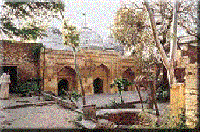Template:AOW90: Difference between revisions
Allenwalla (talk | contribs) m (as this links to the spelling Masjid corrected spelling) |
Hari singh (talk | contribs) No edit summary |
||
| Line 3: | Line 3: | ||
[[Image:Maseet.gif|thumb|200px|left|Guru ki Maseet]] | [[Image:Maseet.gif|thumb|200px|left|Guru ki Maseet]] | ||
In December 1634, [[Guru Hargobind|Guru Hargobind Sahib]] fought a fierce battle against [[Mughal]] forces near the [[river Beas]]. Although heavily outnumbered, the Guru was victorious | In [[December]] [[1634]], [[Guru Hargobind|Guru Hargobind Sahib]] fought a fierce battle against [[Mughal]] forces near the [[river Beas]]. Although heavily outnumbered, the Guru was victorious. | ||
Guru Sahib decided to stay at this location for a while, and soon a settlement grew up at the site. The settlement expanded into a town which became known as [[Sri Hargobindpur]]. As the ongoing conflict with the [[Mughal]]s was intensifying the town's defences were fortified. | |||
In 2001, the mosque was in a state of disrepair and work began on its restoration by a group of [[Sikh]]s and [[Muslim]]s in a unique manifestation of India's multi-religious society. Sikhs offered their labour, Muslim masons repaired the walls and an all-woman team of restorers led by Ms Gurmeet Kaur Rai lent its expertise. {{Aowf|Guru ki maseet}} | In fact, these fortifications were so solid that the original city walls and many buildings within are still visible today throughout [[Sri Hargobindpur]] in [[Gurdaspur]] district, [[Punjab]]. | ||
Residents of all faiths flocked to the Guru and perceived themselves as heirs to the sixth Guru’s desire to found a secure and secular home on the [[river Beas|banks of the Beas]]. The Sikhs built themselves a [[Gurdwara]] but the few local [[Muslim]]s did not have the capacity to build themselves a place of worship. | |||
So they came to the Guru and asked him for help. The All-Knowing Guru was equally comfortable with [[Muslim]] faqirs and [[Hindu]] sadhus and saw all people with one benevolent gaze. The Guru ordered his Sikhs to start construction of a mosque or "[[maseet|Masjid]]". The Masjid was duly completed and turned over to the [[Muslim|Muslims]]. <!--- | |||
In 2001, the mosque was in a state of disrepair and work began on its restoration by a group of [[Sikh]]s and [[Muslim]]s in a unique manifestation of India's multi-religious society. Sikhs offered their labour, Muslim masons repaired the walls and an all-woman team of restorers led by Ms Gurmeet Kaur Rai lent its expertise. --->{{Aowf|Guru ki maseet}} | |||
Latest revision as of 21:19, 26 February 2011
In December 1634, Guru Hargobind Sahib fought a fierce battle against Mughal forces near the river Beas. Although heavily outnumbered, the Guru was victorious.
Guru Sahib decided to stay at this location for a while, and soon a settlement grew up at the site. The settlement expanded into a town which became known as Sri Hargobindpur. As the ongoing conflict with the Mughals was intensifying the town's defences were fortified.
In fact, these fortifications were so solid that the original city walls and many buildings within are still visible today throughout Sri Hargobindpur in Gurdaspur district, Punjab.
Residents of all faiths flocked to the Guru and perceived themselves as heirs to the sixth Guru’s desire to found a secure and secular home on the banks of the Beas. The Sikhs built themselves a Gurdwara but the few local Muslims did not have the capacity to build themselves a place of worship.
So they came to the Guru and asked him for help. The All-Knowing Guru was equally comfortable with Muslim faqirs and Hindu sadhus and saw all people with one benevolent gaze. The Guru ordered his Sikhs to start construction of a mosque or "Masjid". The Masjid was duly completed and turned over to the Muslims. .....More

